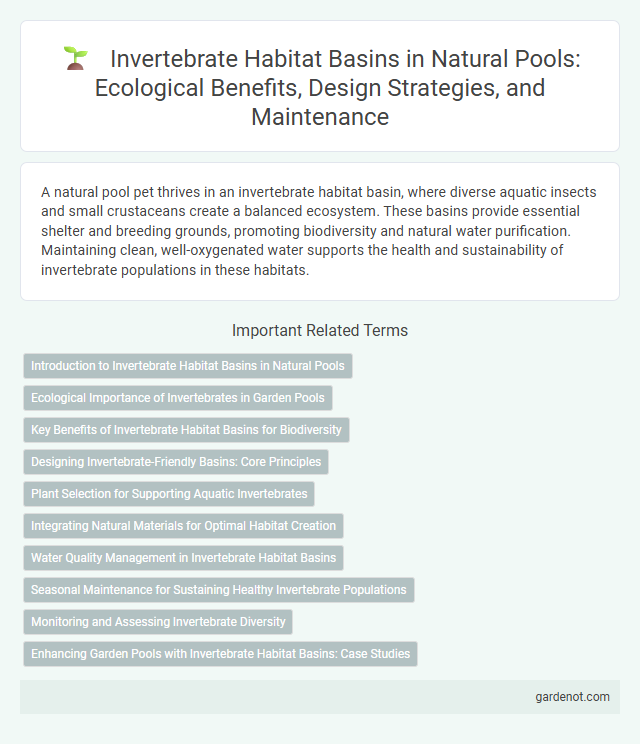A natural pool pet thrives in an invertebrate habitat basin, where diverse aquatic insects and small crustaceans create a balanced ecosystem. These basins provide essential shelter and breeding grounds, promoting biodiversity and natural water purification. Maintaining clean, well-oxygenated water supports the health and sustainability of invertebrate populations in these habitats.
Introduction to Invertebrate Habitat Basins in Natural Pools
Invertebrate habitat basins in natural pools provide essential microhabitats that support biodiversity by offering shelter and breeding grounds for aquatic invertebrates. These basins are designed to mimic natural aquatic environments, promoting water quality through biological filtration by invertebrates such as freshwater shrimp, snails, and insect larvae. Incorporating diverse substrates and vegetation within these basins enhances ecosystem stability and resilience in natural pool systems.
Ecological Importance of Invertebrates in Garden Pools
Invertebrate habitat basins in garden pools are critical for maintaining biodiversity and ecological balance by providing essential shelter and breeding grounds for various species such as dragonflies, water beetles, and snails. These invertebrates contribute to natural water filtration, nutrient cycling, and serve as a primary food source for amphibians and birds. Integrating invertebrate-friendly structures in natural pools enhances water quality and supports sustainable garden ecosystems.
Key Benefits of Invertebrate Habitat Basins for Biodiversity
Invertebrate habitat basins create essential microhabitats that support diverse populations of aquatic insects, mollusks, and crustaceans crucial for ecosystem health. These basins enhance water quality by promoting natural biofiltration through invertebrate activity, leading to improved nutrient cycling and reduced pollutants. Supporting invertebrate biodiversity also strengthens food webs, benefiting fish, amphibians, and bird species within natural pool environments.
Designing Invertebrate-Friendly Basins: Core Principles
Designing invertebrate-friendly basins in natural pools involves creating diverse microhabitats with varying water depths, native aquatic plants, and stable substrates to support species like dragonflies, snails, and freshwater shrimp. Incorporating gently sloping edges and avoiding chemical treatments enhances habitat suitability and promotes biodiversity. Providing ample shelter and food sources ensures a thriving invertebrate community essential for ecosystem balance and water quality.
Plant Selection for Supporting Aquatic Invertebrates
Selecting appropriate aquatic plants such as hornwort, water lilies, and cattails is essential for creating a thriving invertebrate habitat basin in natural pools. These plants provide shelter, breeding grounds, and food sources for diverse aquatic invertebrates like dragonfly larvae, water beetles, and snails. Incorporating native, oxygenating vegetation enhances water quality and supports a balanced ecosystem crucial for invertebrate survival and biodiversity.
Integrating Natural Materials for Optimal Habitat Creation
Integrating natural materials such as rocks, gravel, and native aquatic plants into the invertebrate habitat basin enhances biodiversity by providing shelter, breeding grounds, and food sources for various invertebrate species. Layering organic matter like fallen leaves and wood mimics natural ecosystems, improving water quality and fostering microorganism growth critical for nutrient cycling. Designing habitat complexity within the basin supports ecological balance and promotes the resilience of invertebrate populations essential to the natural pool's health.
Water Quality Management in Invertebrate Habitat Basins
Invertebrate habitat basins play a crucial role in supporting biodiversity within natural pools by providing shelter and breeding grounds for various aquatic species. Effective water quality management in these basins involves monitoring parameters such as pH, dissolved oxygen, and nutrient levels to maintain optimal conditions for invertebrate populations. Implementing filtration systems and controlling runoff are essential strategies to reduce pollutants, enhance water clarity, and promote a stable ecosystem conducive to invertebrate health.
Seasonal Maintenance for Sustaining Healthy Invertebrate Populations
Seasonal maintenance of invertebrate habitat basins in natural pools involves regular removal of excess organic debris and monitoring water quality to prevent harmful nutrient buildup. Maintaining diverse aquatic vegetation supports invertebrate breeding and provides shelter throughout changing seasons. Timely interventions during spring and fall optimize habitat conditions, promoting sustainable invertebrate populations essential for ecosystem balance.
Monitoring and Assessing Invertebrate Diversity
Monitoring and assessing invertebrate diversity in a natural pool's habitat basin involves systematic sampling techniques such as kick-netting and sediment core extraction to capture a wide range of species. Regular biodiversity assessments using standardized indices like the Shannon-Wiener or Simpson's Diversity Index provide critical data on ecosystem health and species distribution. Integrating these methods supports conservation efforts by detecting shifts in invertebrate populations caused by environmental changes or pollution.
Enhancing Garden Pools with Invertebrate Habitat Basins: Case Studies
Invertebrate habitat basins significantly boost biodiversity in garden pools by providing sheltered environments for aquatic insects, mollusks, and crustaceans, essential for a balanced ecosystem. Case studies reveal that incorporating these basins enhances water quality through natural filtration processes and supports local food webs by attracting amphibians and birds. Effective designs use varied substrate layers and native aquatic plants to optimize habitat complexity and increase invertebrate diversity.
Invertebrate habitat basin Infographic

 gardenot.com
gardenot.com